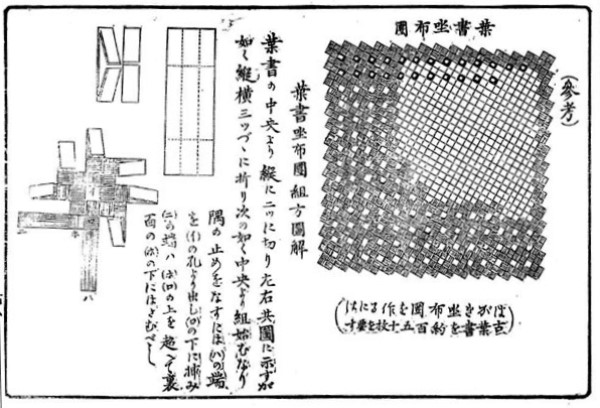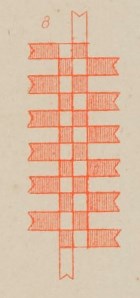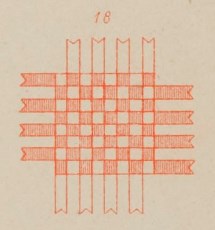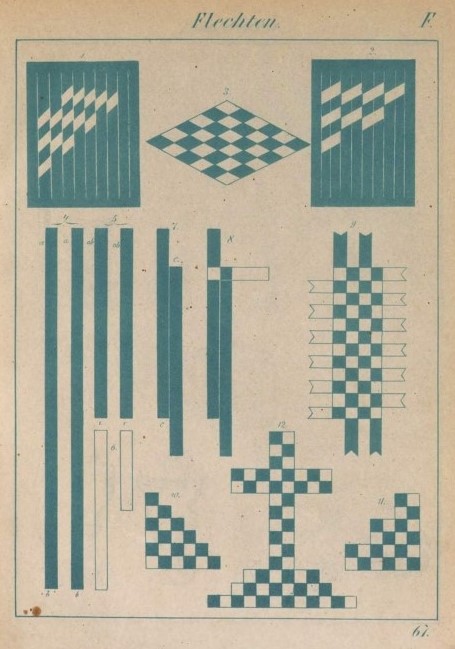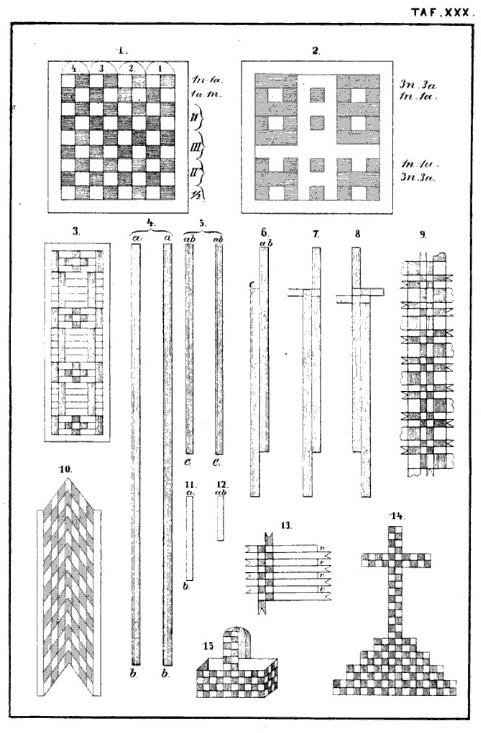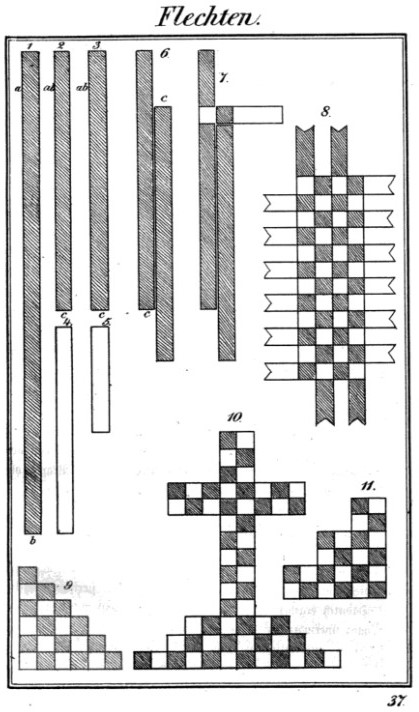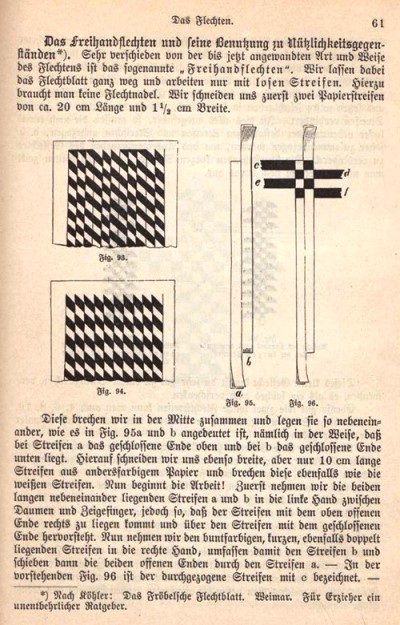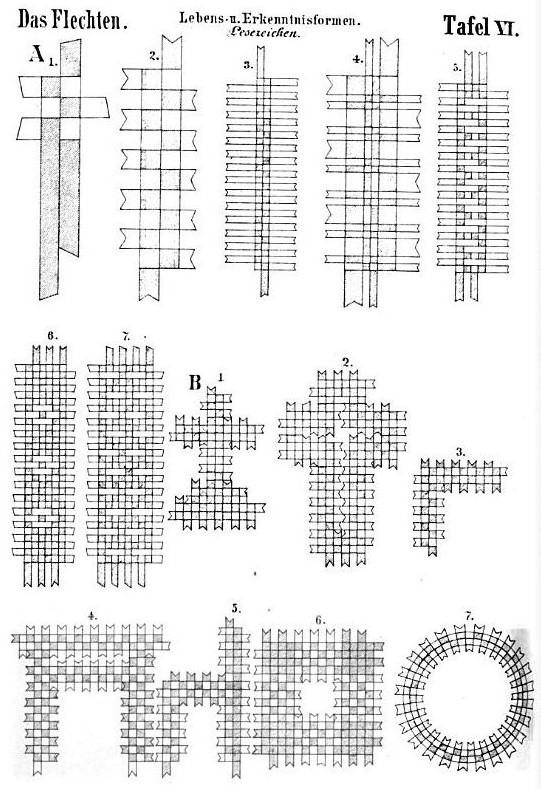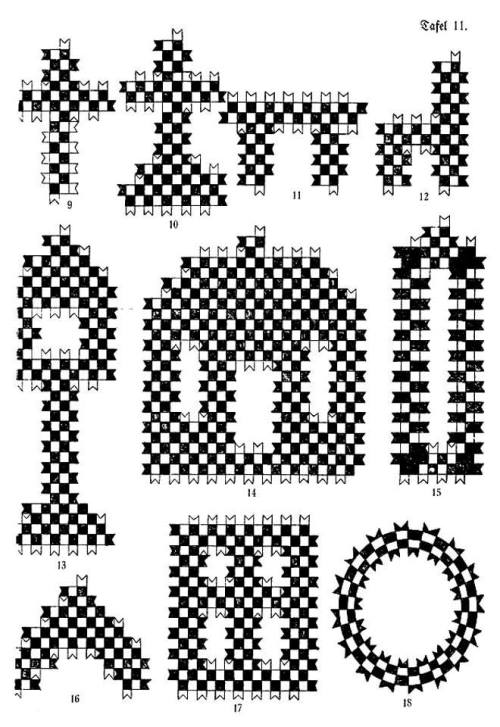| The Public Paperfolding History Project
Last updated 27/2/2024 x |
|||||||
| The Froebelian Occupation of Flechten (Frame Weaving and Free Weaving) | |||||||
| This
page is being used to collect information about the
history of the Froebelian Occupations of Frame Weaving
and Free Weaving. Please contact me if you know any of
this information is incorrect or if you have any other
information that should be added. Thank you. There is a separate page for the Woven Heart design. As far as I know the Free Weaving technique, which uses folded strips, is first recorded in 1833 in 'The Girl's Own Book' by Lydia Marie Child, where it is used to make the Froebel Star. Two other free woven designs, the Woven Cross and the Woven Basket also have their own individual design pages. The Plaited Belt is made by weaving together folded strips in a similar way. ********** Frame Weaving In the original Froebelian occupation of Flechten, or Weaving paper strips were woven through a 'frame' to create patterns. The 'frame' is created by folding a sheet of paper in half then cutting slits into the folded edge before the sheet is unfolded again.
Beyond this, and the fact that both the frame and the strips need to be flexible (ie foldable) to allow the weaving to take place, there is no substantive paperfolding content to this occupation. ********** Free Weaving However, several early Froebelian manuals widen the scope of the original occupation by including designs made by the technique of Free Weaving using paper strips that have been doubled (ie that have been folded in half). In this method the strips are woven so that they go alternately inside and outside each other. ********** In Japan (and in publications by Japanese authors) 1905 'Shukouka Kyohon : Liron Jishuu Souga Setsumei' by Kikujiro Kiuchi, Rokushiro Uehara and Hideyoshi Okayama, which was published by Shigebei Takase in Chiba in 1905, contains several pages of instructions for making Free Weaving designs.
********** In Western Europe and the Americas 1863 The basic technique of free weaving appears in 'De Kleine Papierwerkers: Volume 2: Wat men uit strookjes papier al vlechten kan' which was published by K H Schadd in Amsterdam in 1863.
********** 1869 The chapter on the Froebelian occupation of 'Flechten' in 'Der Kindergarten' by Hermann Goldammer, which was published by Habel in Berlin in 1869, illustrates a number of designs made by weaving together paper strips that have been doubled / folded in half.
********** The same illustrations is to be found in 'Paradise of Childhood' by Edward Wiebe, which was published by Milton, Bradley and Company in Springfield, Massachusetts in 1869. ********** Information about Free Weaving also appears: 1873 In 'Die Praxis Des Kindergartens' by Auguste Koehler, which was published by Herman Bohlau in Weimar in 1873.
********** 1874 In the revised and updated third edition of 'Der Kindergarten' by Hermann Goldammer, which was published by Carl Babel in Berlin in 1874.
********** In 'Spiel und Arbeit' by Hugo Elm, which was published by Verlag und Drud der Otto Spamer in Leipzig in 1874.
********** 1882 In 'The Kindergarten Guide' by Maria Kraus Boelte and John Kraus, which was first published in single volume form by E. Steiger and Company in New York in 1882. ********** 1887 In Part 2 'Die Praxis' of 'Theoretisches und praktisches Handbuch der Fröbelschen Erziehungslehre' by Bertha von Marentholtz-Bülow, which was published by George H Wigand in Kassel in 1887.
********** 1889 In 'Royal Gifts for the Kindergarten' by Frances Post Van Norstrand and Alice H Putnam, which was published by the Standard Publishing Company in Chicago in 1889
********** 1900 In 'Introduccion a la Ensenaza Practica del Sistema de Kindergarten' by Ernesto Steiger, which was published by E Steiger and Co in New York in 1900. ********** 1910 In Part 1: 'Das Flechten' (Weaving) of 'Die Frobelschen Beschaftigungen' by Marie Muller-Wunderlich, which was published by Friedrich Brandstetter in Leipzig in 1910.
********** |
|||||||

